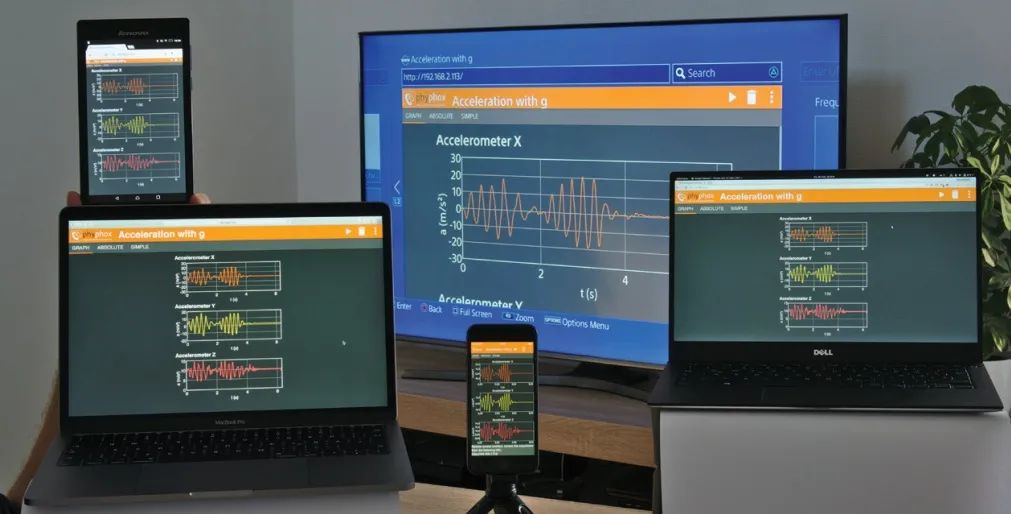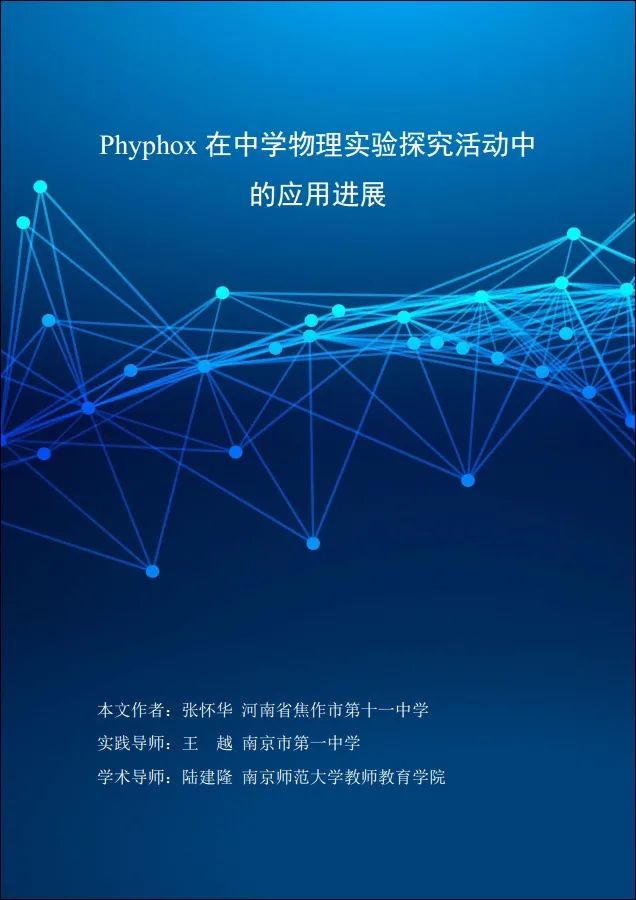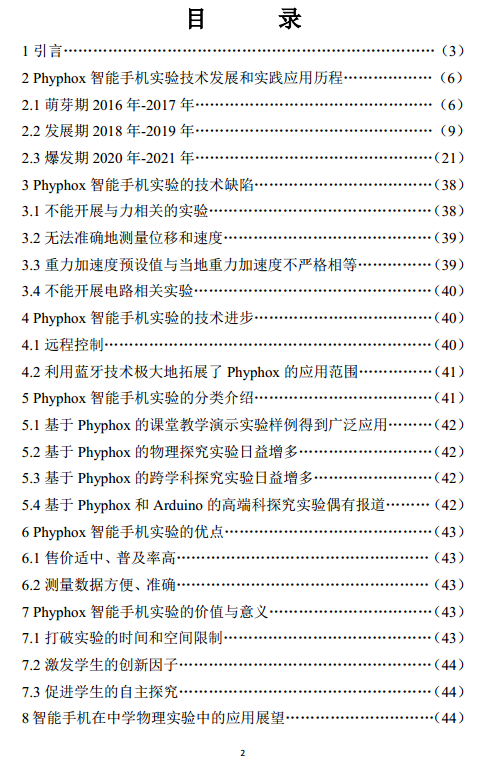
After more than 40 days of preparation, over 20 days of literature search, translation, reading, and organization, and 14 consecutive days and nights of writing without rest, the first draft of the literature review “Progress of Phyphox in Secondary Physics Experimentation” has been freshly produced with the careful guidance of several professors from Nanjing Normal University and Henan Normal University, spanning 52 pages and 24,000 words.

Cover
Related videos of Phyphox smartphone experiments

Table of Contents

Brief Introduction
The mobile physics workshop (Phyphox), which is highly integrated with secondary school scientific inquiry activities and physics experiment teaching, was launched by the Institute of Physics at RWTH Aachen University in Germany in 2016. It is free, open-source, and allows users to develop freely according to their needs. As of January 2020, Phyphox has over 1 million global users.
During the COVID-19 pandemic, Phyphox became popular worldwide as online teaching surged. Reports of students of all ages conducting scientific inquiry experiments at home using Phyphox have frequently appeared. Although Phyphox has been around for less than 6 years, nearly a hundred relevant domestic and international literature pieces have been retrieved on the China National Knowledge Infrastructure (CNKI) using Phyphox as the keyword.
Technological Advancements of Phyphox Smartphone Experiments
From 2016 to the present, Phyphox has achieved three technological breakthroughs over six years, making its functions increasingly powerful and its connection to secondary school physics inquiry learning activities even closer.
In 2016, the Institute of Physics at RWTH Aachen University released the initial version of Phyphox, which came with a rich set of experimental examples. However, when smartphones are used for experiments, especially when they are in motion, controlling the smartphone becomes quite inconvenient.
In 2017, the development team added a “remote control” feature, allowing access to a moving smartphone from another stationary device on the same WiFi or wireless hotspot. Users can view the screen of the moving smartphone and control it conveniently. The development team also implemented a custom feature, allowing users to log in to the https://phyphox.org/editor page to customize their personalized smartphone experiments, which is very convenient.
In 2020, the development team achieved Bluetooth connectivity between Phyphox and Arduino or ESP32 development boards. By using Arduino or ESP32 to collect signals such as pressure, temperature, voltage, current, resistance, capacitance, and inductance that smartphones cannot or find inconvenient to collect, and then sending these signals to the smartphone via Bluetooth after necessary calculations, Phyphox can call and participate in calculations and data or function graph outputs of various sensor data inside the smartphone. This realizes perfect integration of the smartphone’s internal sensors with various external sensors connected to Arduino or ESP32.
This integration greatly expands the application range of Phyphox, covering almost all modules and chapters of secondary school physics subjects, and holds extremely broad application prospects in secondary physics experiment teaching and inquiry-based learning activities.
Technical Defects of Phyphox Smartphone Experiments
Experiments related to force cannot be conducted. Since smartphones do not have force sensors, the Phyphox smartphone experiment program cannot conduct experiments related to interactions.
Accurate measurement of displacement and velocity is not possible. Due to the relativity of motion, smartphones do not have displacement sensors and cannot directly measure their position changes; although GPS positioning can measure displacement and velocity, it works well for long-distance motion, but for short-distance motion often encountered in experiments, using GPS for measuring displacement and velocity leads to significant errors, rendering it unusable.
Another way to measure displacement and velocity is to use the accelerometer to measure the smartphone’s acceleration, integrate the acceleration to get velocity, and integrate the velocity to get displacement. However, this method accumulates significant errors over time, making it very unreliable and also unusable.
In fact, a workaround is to use small magnets or LED lights distributed evenly along a straight line or curve, using a magnetometer or photometer to sense the magnetic field or light intensity near these small magnets or LED lights to determine the motion pattern of the smartphone. However, this method of studying object motion using spatial periodicity is inconsistent with the common method of studying object motion using temporal periodicity in textbooks, which not only increases experimental operational difficulty but also complicates the analysis and processing of experimental data.
The preset value of gravitational acceleration does not strictly equal the local gravitational acceleration. In the Phyphox smartphone experiment program, the development team sets the preset value of gravitational acceleration at 9.81 m/s², using this value as a design reference for the linear accelerometer. Since the value of gravitational acceleration varies across the globe, this leads to a small acceleration output value when the smartphone is at rest, instead of zero.
If the study is merely about the smartphone’s acceleration, this small acceleration output value may be regarded as experimental error; however, when using acceleration integration to derive velocity, this small acceleration value can accumulate into a significant measurement error, leading to experimental failure.
It is inconvenient to conduct experiments related to circuits. Since smartphones do not have voltage and current sensors, the Phyphox smartphone experiment program cannot conduct inquiry experiments related to voltage and current.
Although Phyphox can currently integrate with Arduino or ESP32 using Bluetooth technology to collect voltage and current signals and transmit them to smartphones for conducting inquiry experiments related to voltage and current, the technical barrier for integrating Phyphox with Arduino or ESP32 via Bluetooth is quite high, which may prevent most teachers and students from accessing it.
Prospects for Smartphone Applications in Secondary Physics Experiments
Despite the Phyphox smartphone experiment program being released in 2016 and gaining worldwide popularity during the COVID-19 pandemic, most applications of Phyphox are superficial, often relying on the examples provided with the Phyphox smartphone experiment program; reports on innovative applications based on the examples provided by Phyphox are relatively few; reports on personalized innovative experiments based on the Phyphox smartphone experiment program are even scarcer; and due to the technical barriers of Arduino programming and Bluetooth usage, reports on high-end physics inquiry experiments that integrate Phyphox with Arduino or ESP32 via Bluetooth are even rarer.
Currently, a Phyphox Bluetooth experiment research team has been established by teachers Zhang Huaihua from the Eleventh Middle School of Jiaozuo City, Mei Xiaoxuan from the First High School of Heping Street in Beijing, Zhan Shansheng from the First High School of Chizhou City in Anhui Province, and Su Xiang from the Southwest University Affiliated High School in Chongqing in September 2020. They have set up a column on the WeChat public platform “Maker Jiaozuo” titled “Research on the Application of Intelligent Technology in Autonomous Learning” and have initially opened up the technical channel between Phyphox and Arduino or ESP32, developing a large number of physics inquiry experiments based on the integration of Phyphox with Arduino or ESP32 technology.
It can be anticipated that in the near future, there will be a wave of utilizing Phyphox smartphone experiment programs to conduct customized personalized innovative experiments globally, and a large number of enthusiasts researching the integration of Phyphox with Arduino or ESP32 will emerge.
Conducting physics inquiry experiments using the Phyphox smartphone experiment program has become an unstoppable trend.

| Maker Jiaozuo |
HenanMaker Jiaozuo is the WeChat public platform of the Jiaozuo City Maker Education Master Studio, focusing on maker education research, sharing maker cases, explaining innovative methods, inspiring creative design, conducting scientific inquiry, organizing social surveys, guiding thesis writing, participating in maker competitions and patent applications, discovering, cultivating, and achieving a group of students with innovative potential.
HenanPublic Number: chuangkejiaozuo
HenanMaster Blog: http://blog.sina.com.cn/updays

Long press to identify, follow, and share
– END –
